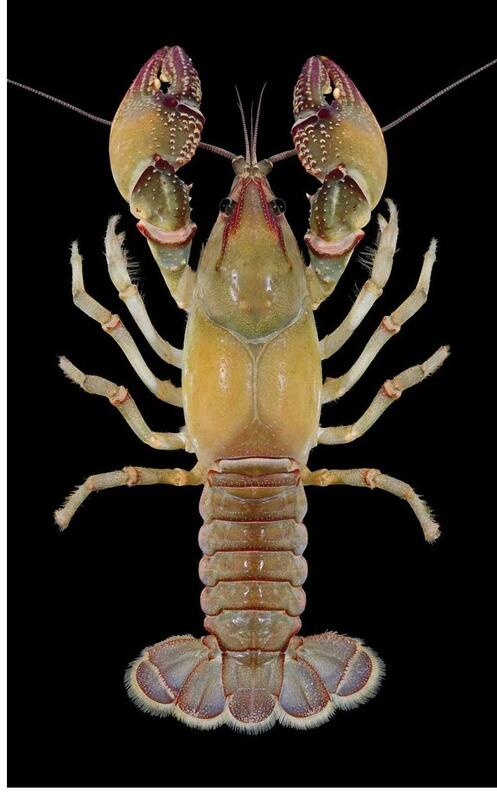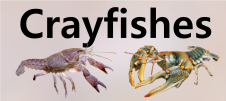







Loading profile. Please wait . . .
Lacunicambarus diogenes (Girard, 1852)
Devil Crawfish




Federal Protection: No US federal protection
State Protection: No Georgia state protection
Global Rank: G5
State Rank: S5
Element Locations Tracked in Biotics: No
SWAP 2015 Species of Greatest Conservation Need (SGCN): No
SWAP 2025 Species of Greatest Conservation Need (SGCN): No
2025 SGCN Priority Tier: None
Element Occurrences (EOs) in Georgia: 0
Habitat Summary for element in Georgia: Complex burrows adjacent to streams and ditches, or low areas where water table is near surface of ground; juveniles and gravid females may be found in streams
The overall color of the Devil Crawfish is light brown or tan to olive with abundant red highlighting. The fingers of the claws are red as well as the mesial margin of the palm. The rostrum and adjacent postorbital ridges are red as are the rear margins of each abdominal segment. There are typically three or more rows of tubercles along the mesial margin of the palm and the areola is obliterated. The rostrum typically tapers somewhat and does not have marginal spines or tubercles. The claws of adults of this species can be quite large and deliver a painful pinch. This species reaches a maximum total body length of about 96 mm (3.8 in). Note: First, Lacunicambarus was formerly a subgenus of the genus Cambarus but was elevated to the genus level by Glon et al. (2018). Second, recent taxonomic work suggests Devil Crawfish is a complex of species. Two described forms (Lacunicambarus dalyae and L. erythrodactylus) may occur in western-southwestern Georgia, replacing Devil Crawfish there (Glon et al. 2018; Simon and Morris 2015). Until additional fieldwork is completed to determine the distribution of these newly described species we will recognize all forms in Georgia as Devil Crawfish.
Within its range, the Devil Crawfish would most likely be confused with the Dougherty Burrowing Crayfish, Cambarus doughertyensis, or the Ambiguous Crayfish, Cambarus striatus. However, neither of these species has the red coloration exhibited by Devil Crawfish and they both have two rows of tubercles along the mesial margin of the palm rather than three or more found on the Devil Crawfish.
Complex burrows adjacent to streams and seepage areas, or in low areas where the water table is near the surface of the ground. Juvenile Devil Crawfish and females with eggs are often found within streams under rocks or among woody debris (Hobbs 1981).
No studies of the Devil Crawfish are known. Crayfishes are considered opportunistic omnivores and likely feed on live and decaying vegetation, aquatic insect larvae, small fishes, and dead animal matter. Devil Crawfish have been observed at night in the mouths of their burrows possibly waiting to ambush prey.
Burrowing crayfishes inhabit a system of tunnels that may be very complex with several openings to the surface. Openings to the tunnels are often marked by piles of dirt or mud pellets (chimneys). Depending on the soil type and moisture content, these chimneys can reach heights of 15 cm (6 inches) or more. These crayfishes are typically confined to their burrows, but a male must leave its burrow to search for females during the reproductive season. As mentioned above, they may also forage near the opening of their burrow. Active burrows with fresh soil are seen from late spring to late fall, particularly after rain events. During the dry part of the summer, burrow openings may be plugged to help conserve moisture in the burrow. Reproduction probably occurs during the spring and fall, but males in reproductive condition may be found at any time during the year. It is rare to find more than one adult crayfish in the same burrow. When a female crayfish releases her eggs, she attaches them to her swimmerets and is said to be “in berry.” Upon hatching, the juvenile crayfish are attached to the mother by a thread. After the juveniles molt for the second time, they are free of the mother, but stay close and will hold on to her for some time. Multiple juveniles are occasionally found in a single burrow. Eventually they move off on their own. Crayfishes molt 6 or 7 times during their first year of life and most are probably able to reproduce by the end of that year. They molt once or twice a year for the remainder of their lives. Although it is difficult to study burrowing crayfishes, some researchers believe they may live as long as 10 years. Male Devil Crawfish in reproductive condition have been collected in Georgia in January, April, and October. In nearby areas of Florida and Alabama they have also been found in March, May, November, and December. One female carrying eggs (40) was found in September in Georgia and two in Alabama in April. Miller et al. (2014) found 4 females carrying eggs in southeastern Alabama in March. The smallest first form male known is about 70 mm (2.75 in) in length and the only Georgia female carrying eggs was about 88 mm (3.4 in) in length (Hobbs 1981).
Burrowing crayfishes may be collected by direct excavation of their burrows, by trapping, and during night surveys. Excavating burrows is time consuming and can be very difficult. It also results in destruction of the animals’ burrow. Traps made with PVC pipes or mist nets can be effective, but only when crayfishes are in an active period. Burrowing crayfishes are sometimes captured around the openings of their burrows on damp nights. It is possible to find active burrows from about mid-March to mid-November if the water table is within about 2 feet of the surface of the ground. However, most activity is seen in the spring from mid-March to mid-May and the fall from mid-September to mid-November. Since juveniles and females with eggs or young can be found in streams, surveys targeting this species should include looking under rocks and woody debris.
The Devil Crawfish is one of the most widespread species in North America. It is found in every state east of the Rocky Mountains except the New England states north and east of New York and New Jersey. In Georgia it is primarily found in the Coastal Plain portion of the Flint and Chattahoochee river systems, although there are a few records from the Ocmulgee and Savannah systems as well (Hobbs 1981, 1989).
Activities that destroy burrows or alter hydrology in the vicinity of burrows threaten this and other burrowing species.
This species common and widespread and is apparently stable in Georgia.
Areas with burrows should be protected from land disturbing activities and activities that could alter groundwater resources. Environmental education programs should include information about burrowing crayfishes and encourage protection of burrows.
Glon, M.G., R.F. Thoma, C.A. Taylor, M. Daly, and J.V. Freudenstein. 2018. Molecular phylogenetic analysis of the devil crayfish group, with elevation of Lacunicambarus Hobbs, 1969 to generic rank and a redescription of the devil crayfish, Lacunicambarus diogenes (Girard, 1852) comb. nov. (Decapoda: Astacoidea: Cambaridae). Journal of Crustacean Biology 2018:1-14.
Hobbs, H. H., Jr. 1981. The crayfishes of Georgia. Smithsonian Contributions to Zoology 318:1–549.
Hobbs, H.H., Jr. 1989. An Illustrated Checklist of the American Crayfishes (Decapoda: Astacidae, Cambaridae, and Parastacidae). Smithsonian Contributions to Zoology 480:1–236.
Miller, J.M., B.B. Niraula, E.G. Reátegui-Zirena, and P.M. Stewart. 2014. Life history and physical observations of primary burrowing crayfish (Decapoda: Cambaridae) Cambarus (Lacunicambarus) diogenes and Cambarus (Tubericambarus) polychromatus. Journal of Crustacean Biology 34:15–24.
Simon, T. P., and C. C. Morris. 2015. Cambarus (Lacunicambarus) erythrodactylus, a new species of crayfish (Decapoda: Cambaridae) of the Cambarus diogenes complex from Alabama and Mississippi, USA. Proceedings of the Biological Society of Washington 127:572–584.
Taylor, C.A., G.A. Schuster, J.E. Cooper, R.J. DiStefano, A.G. Eversole, P. Hamr, H.H. Hobbs III, H.W. Robison, C.E. Skelton, and R.F. Thoma. 2007. A reassessment of the conservation status of crayfishes of the United States and Canada after 10+ years of increased awareness. Fisheries 32:372–389.
Christopher E. Skelton
C. Skelton, 2012: original account
C. Skelton, February 2019: general update of account.